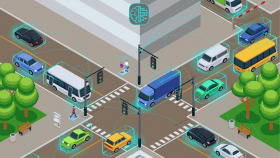- November 12th, 2021
- 0 Comments

First up, researchers at Georgia Institute of Technology and Stanford University have developed a new quadruped robot that can efficiently navigate sidewalks in urban environments. "While we made a lot of progress in sim-to-real transfer for navigation, there are still many challenges remaining," says one of the researchers, Maks Sorokin, "including road crossing, dynamic obstacle handling, and interaction with real-world objects and humans." In time, the quadrupedal robot developed by this team of researchers has potential to be perform any number of duties from delivering parcels to monitoring urban environments.
Next, when installed at roads and intersections, LiDAR sensors monitor and autonomously collect traffic data, including how and when people and vehicles use this critical infrastructure. From counting how many pedestrians are jaywalking to measuring vehicle traffic volume and identifying speeding vehicles, LiDAR is capable of collecting a lot of information. According to this recent article from Mass Transit Magazine, examining this data to identify patterns, predict safety hazards, and ultimately inform transportation policies to improve pedestrian and cyclist safety is just the tip of the iceberg. The article details exactly how LiDAR-based traffic intelligence works, reviews five key benefits of LiDAR for traffic monitoring, and details a few case studies.
And last, German rail operator Deutsche Bahn and industrial group Siemens unveiled the world's first automated, driverless train in Hamburg. Four of these new self-driving trains will join the city's S-Bahn rapid urban rail network and start carrying passengers using existing rail infrastructure this December, with plans to digitalize the entire system by the end of the decade. Fully automated using digital technology, a human driver remains onboard to supervise any journey with passengers on board, but procedures such as "shunting" (or turning the train around) is done entirely without on-board personnel.
Dr. Richard Lutz, CEO of Deutshe Bahn, said "Today we're experiencing the true turn of an era: The railroad has arrived in the digital future and Digital Rail Germany has become a reality. With automated rail operations, we can offer our passengers a significantly expanded, more reliable and therefore improved services – without having to lay a single kilometer of new track."













